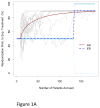Worth adapting? Revisiting the usefulness of outcome-adaptive randomization
- PMID: 22753588
- PMCID: PMC3495976
- DOI: 10.1158/1078-0432.CCR-11-2555
Worth adapting? Revisiting the usefulness of outcome-adaptive randomization
Abstract
Outcome-adaptive randomization allocates more patients to the better treatments as the information accumulates in the trial. Is it worth it to apply outcome-adaptive randomization in clinical trials? Different views permeate the medical and statistical communities. We provide additional insights to the question by conducting extensive simulation studies. Trials are designed to maintain the type I error rate, achieve a specified power, and provide better treatment to patients. Generally speaking, equal randomization requires a smaller sample size and yields a smaller number of nonresponders than adaptive randomization by controlling type I and type II errors. Conversely, adaptive randomization produces a higher overall response rate than equal randomization with or without expanding the trial to the same maximum sample size. When there are substantial treatment differences, adaptive randomization can yield a higher overall response rate as well as a lower average sample size and a smaller number of nonresponders. Similar results are found for the survival endpoint. The differences between adaptive randomization and equal randomization quickly diminish with early stopping of a trial due to efficacy or futility. In summary, equal randomization maintains balanced allocation throughout the trial and reaches the specified statistical power with a smaller number of patients in the trial. If the trial's results are positive, equal randomization may lead to early approval of the treatment. Adaptive randomization focuses on treating patients best in the trial. Adaptive randomization may be preferred when the difference in efficacy between treatments is large or when the number of patients available is limited.
©2012 AACR.
Conflict of interest statement
There is no conflict of interest to declare for all authors.
Figures


References
-
- Peirce CS, Jastrow J. On small differences in sensation. Memoirs of the National Academy of Sciences. 1885;3:73–83. http://psychclassics.yorku.ca/Peirce/small-diffs.htm.
-
- Hacking I. Telepathy: origins of randomization in experimental design. Isis. 1988;79:427–51.
-
- Stigler SM. Mathematical statistics in the early states. Ann Statist. 1978;6:239–65.
-
- Stigler SM. A historical view of statistical concepts in psychology and educational research. Am J Educ. 1992;101:60–70.
-
- Fisher RA. Statistical methods for research workers. London: OIiver and Boyd; 1925.
Publication types
MeSH terms
Grants and funding
LinkOut - more resources
Full Text Sources
Medical

